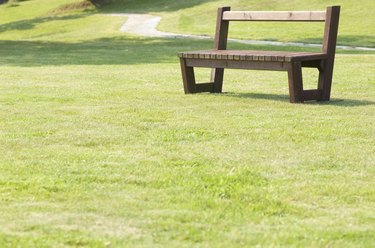
Since only a handful of reasons exist why a lawn will turns yellow, with a little troubleshooting and investigating, it should be simple to figure out what is causing the condition. Once you know what the problem is, you'll be in the position to apply the appropriate remedy.
Water and Nutrients
Video of the Day
Start by taking a soil sample to determine if the lawn is nitrogen deficient. Lawns lacking nitrogen will begin to yellow -- and often become more susceptible to weeds like white clover (Trifolium repens), which thrive in nitrogen-deficient soil. If the soil sample shows sufficient nitrogen, then test the moisture level.If it is excessively dry, irrigating the lawn deeply, but infrequently, should help restore the natural green color of the lawn. Clover is hardy in U.S. Department of Agriculture plant hardiness zones 3 through 9.
Video of the Day
Cutting Too Short
Another common reason for a yellowing lawn is mowing the grass too short, since this can weaken and damage the roots. If you cut grass too short and leaves an excessive amount of clippings, you can smother and kill sections of the lawn. Reduce the frequency of mowing and raise the cutting height on the mower. A good rule of thumb is to never remove more than one-third of the grass blade in a single cutting. However, if your lawn is yellow, but changes colors to pink, gray or black it could be an indicator of lawn disease: snow mold or smut.
Pets and Herbicides
If the yellowing is restricted to areas of the lawns and you have a dog -- it could simply be where the animal urinated. This is because dog's urine contains nitrogen which will "burn" a circular spot in the grass. Solve this by running a water hose over the area to dilute the nitrogen or supplement the dog's diet to try and alter the pH balance of the urine. If you don't have a dog, but recently treated your lawn with a weed killer, it may be the herbicide that is causing the lawn to yellow. Try spot-killing the weeds instead of applying a herbicide to the entire lawn. (Reference 2)
Poor Lawn Habits
Some common errors can also cause your lawn to yellow. Mowing with a dull blade can tear the grass blades instead of shearing them, weakening the grass and causing it to yellow, as can mowing a lawn when it is too wet -- it can cause the soil to become compacted, prohibiting water and nutrients from reaching the roots. Spilling gasoline on the lawn when filling your lawn mower can also cause dead, yellow spots.
Proper Care
Creating a healthy lawn requires some work -- including following a regular schedule of feeding, mowing, irrigating, aerating and, when necessary, removing weeds from the lawn. Since each grass variety has its own specific mowing height and nitrogen requirements, knowing what they are will help you keep the lawn healthy. Also, taking a little time every spring to sample the soil, to level out the lawn and to determine how much and how frequently to feed the grass will go a long way in keeping your lawn green and healthy.
- Landscaper.Org: What to Do When Your Grass Is Yellow
- Lowes: Troubleshoot Lawn Damage and Diseases
- Cornell University: Mowing
- University of California Agricultural and Natural Resources: Lawn Watering Guide For California
- University of California Agricultural and Natural Resources: Lawn Care for Established Lawns
- Learn2Grow: Trifolium repens